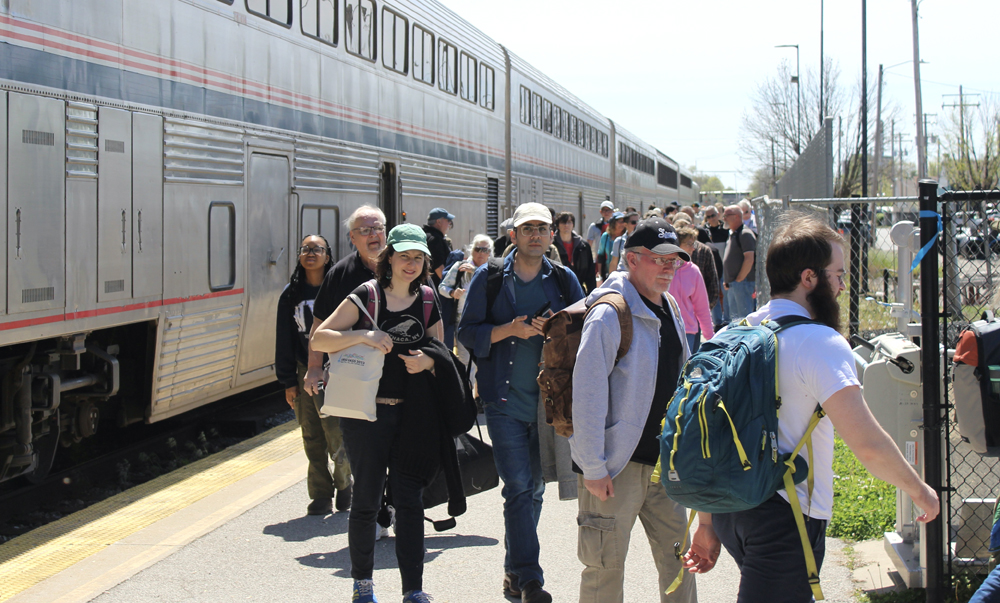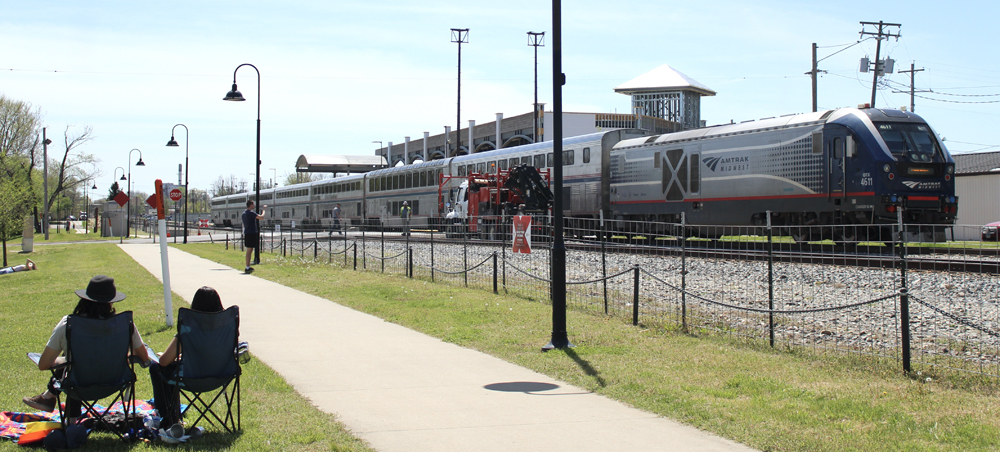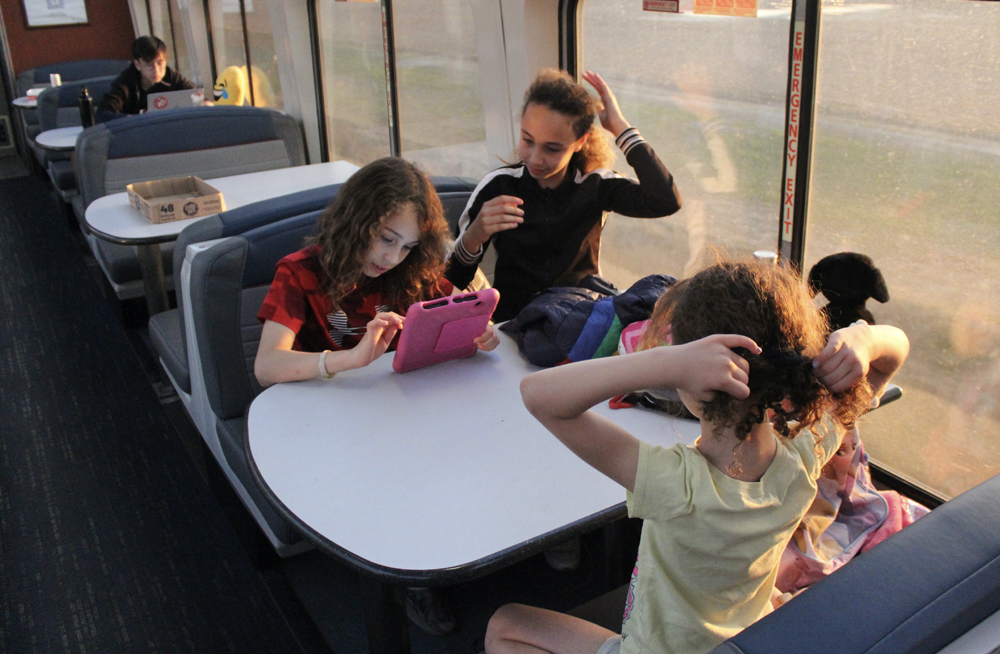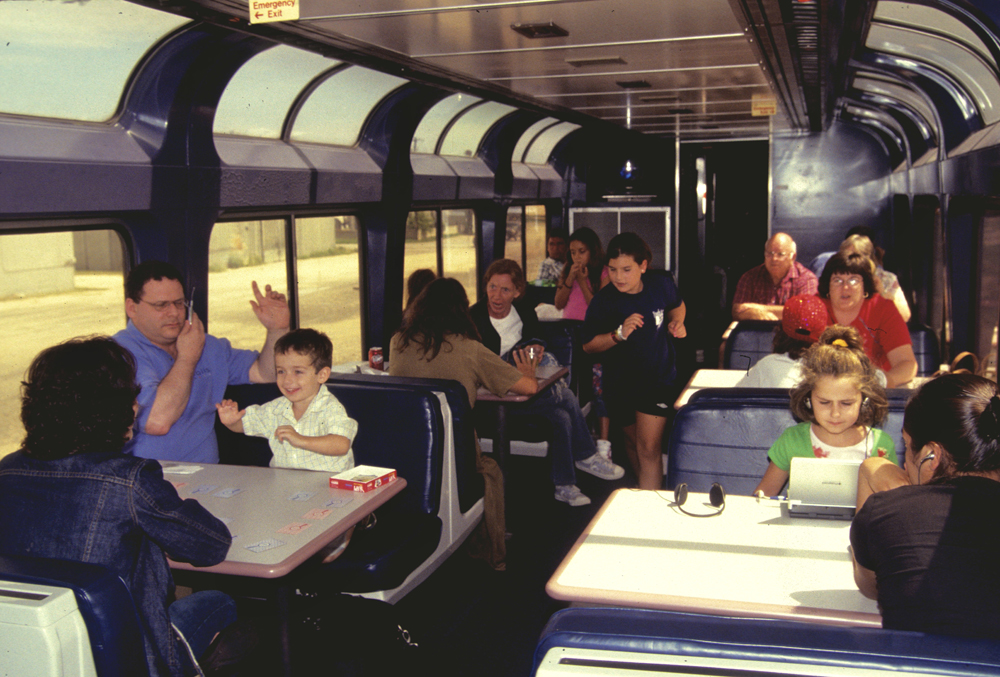
CHICAGO — More than 430 passengers rode at least a portion of Amtrak’s southbound Saluki and northbound Illini between the Chicago and Carbondale, Ill., on Monday. Many were taking advantage of a schedule change which made it possible for customers to witness a rare four minutes of totality in the southern Illinois city during the April 8 solar eclipse [see “Amtrak modifies April 8 schedules …,” Trains News Wire, March 22, 2024].
Far from everyone aboard the sold-out trains was on a one-day excursion. That’s because these trains comprise one of three round trips (including the City of New Orleans) providing daily mobility through central Illinois. Amtrak spokesman Marc Magliari tells News Wire that Monday’s morning southbound Saluki No. 391 reached its maximum passenger count of 313 passengers leaving Champaign, Ill., while the late afternoon northbound Illini hit its peak load of 325 pulling out of Effingham, Ill. The difference between those numbers and the “total carried” figures of 432 and 437, respectively, reveals that more than 100 seats on each train changed occupants during the trips.
This is typical of most Amtrak intercity trains, both regional and long distance. The more capacity a train can offer, the greater the opportunity to accept extra travelers whose trips may not synch with when others vacate seats or sleeping-car space.
Each of the April 8 departures was intermittently sold out for weeks in advance, even before Amtrak made its schedule adjustment. Some passengers interviewed on each train could only book one way because it was either sold out in the other direction, or the southbound run’s schedule had not been revised when they made travel plans. More people could have been accommodated if Amtrak had been able to provide additional coaches [see “Superliner shortage limits Illinois eclipse viewing …,” News Wire, April 5, 2024].
Host railroad Canadian National requires seven Superliners to be assigned on the route [see “Seeking answers on loss of shunt …,” News Wire Sept. 6, 2023. Of those, four coaches are generally sufficient to handle regular patronage. The other three are “axle-count” Superliner. They are often cars that are not suitable for revenue service for a variety of reasons (for example, inoperable air conditioning), and, since they are not occupied, can be of any available car type.
Monday’s Saluki/Illini Superliner consist looked like this:
— Two accessible coaches with lower-level seating.
— One coach-baggage: the lower level compartment accommodates roll-on-bicycles; there is no checked baggage.
— One coach-café: half of upper level is business class; café is on lower level
— One coach-café: normally carried unoccupied as “axle count” car
— One Sightseer Lounge: unoccupied axle count car
— One transition sleeping car: unoccupied axle count car
Management did open up the axle-count coach-café for sale the previous week and seats were quickly sold. Additional onboard service staff and supervision was on hand in the active coach-café to handle the expected crowds, and serving began shortly after departure. With so many passengers on the train, lines quickly formed in the downstairs hall back to the bathrooms and stairwell when the morning train left Chicago, but the efficient attendants kept service moving and made announcements encouraging travelers to “come on down” when there was a lull.

Any Superliner equipment can be tapped for axle count duty and those cars are always closed to revenue passengers, as they were on the southbound Saluki. Conductors set up shop in the Sightseer lounge, but discussion by employees overheard in the working café noted that the car hadn’t been cleaned. The ordeal of shifting food and beverage stock for the northbound trip was out of the question, but someone suggested that the Sightseer lounge could be cleaned along with the coaches during the Carbondale layover. Its designated axle-count status would also have to be reversed.
Sure enough, the Sightseer lounge interior — if not the grime-caked exterior — was spotless as passengers boarded the afternoon northbound run. Although the “employees only” sign had been switched from the lounge communicating door to the transition sleeper’s inside door, conductors never announced the car’s availability.

What they did do, however, was direct passengers traveling in groups of two or more boarding at stops after Carbondale to “keep walking” to the front of the train, knowing that finding two seats together would otherwise be difficult. The result: the Sightseer filled up with travelers who would otherwise have been separated.
On long-distance trains, Amtrak coach attendants and conductors generally work off manifest information to block coach seats so that everyone can sit together. That would have been a challenge, but not impossible, here, with hundreds of passengers boarding at the train’s origination point and no assigned coach attendants.
The big takeaway, though, is that the Sightseer lounge is a valuable asset that can add “only on a train” enjoyment to the travel experience, not just in the safety valve role it played on April 8. Anyone could see that on the faces and behavior of happy travelers. Every table and nearly every seat was filled following stops at Du Quoin, Centralia, and Effingham. Conductors stayed in the lower level and food service wasn’t offered; so what? It was the lounge space that mattered. The coach-café four cars back continued to do brisk business.

Two long-distance trains with Sightseer lounges prior to 2021, the Texas Eagle and Capitol Limited, no longer have them. The Superliner fleet has, of course, been thinned by wreck damage resulting from subsequent Empire Builder and Southwest Chief derailments, and Amtrak has cited manpower shortages in its maintenance ranks for car-shortage issues. But that Sightseer Lounge No. 33008 has been commoditized as an axle-count car — along with the fact seven lounges are not available for daily operation on the Eagle and Capitol — indicates Amtrak leadership fails to appreciate the value of the cars and has not prioritized returning them to service.
On the Eagle, one part the Sightseer Lounge played, as orchestrated by the volunteer Texas Eagle Marketing and Performance Organization and now-retired Amtrak employee Griff Hubbard, was transporting elementary school groups between intermediate stops. That promotional value has since been squandered, while others aboard have lost the convivial environment enjoyed by Chicago-St. Louis and Texas corridor passengers.
Monday’s Saluki/Illini round trip reveals no management mechanism in place to recognize the contribution a Sightseer Lounge can make to passenger enjoyment on trains sold out well in advance. Fortunately, employees delivering the service stepped in to make that happen.
— Updated at 5:35 p.m. CT to correct caption information on second photo.














The employees will probably get fired for doing this. Trying to be helpful to the customers is not acceptable anymore. Just being sarcastic. No need to roast me.
Rode Brightline to Miami yesterday. What a difference from Amtrak. Clean modern equipment, excellent attention to detail, professional friendly staff, hourly service, fast trains.
Now Amtrak, disfunctional. Management needs to change.
Cars not repaired, consists that do not meet demand, limited service, many times dirty equipment. Why are these issues allowed to continue?
Because AMTRAK is a government agency that anymore seems to exist to exist. Brightline is a private operation that has to built its business to survive.
If only Amtrak leadership was as resourceful as its on-train operations staff. Hmmm…
They should try digital shunting south of Mattoon. Stop the analog, old school, wheel changing the voltage stuff.
Funny that BNSF only requires 12 axles to activate grade crossing flashing light.
Why doesn’t CN, Illinois and Amtrak to address the problem track between Mattoon and Kinmundy?
I remember in the 80’s the Illini when it ran to Champaign, the consist was an F40PH and two or three ex Northwestern intercity bi level coaches.
Or as someone stated earlier, why don’t Amtrak and Illinois buy some surplus Caltrain double deck cars and refurbish them for intercity service?
Amtrak is getting record setting funding and nothing to show for it. If coscia and Gardner have their way, all that money will go to their precious nec.
As I’ve said before, it’s been Red Sky at Morning at Amtrak
Oh and once again, the speed limit from Champaign to Centralia was 110 MPH back in the day with single level equipment
“Amtrak is getting record setting funding and nothing to show for it.”
That is because Amtrak leadership would rather get large bonuses than hire essential workers to repair damaged or out of service equipment. But I imagine the NEC passengers are happy with their subsidized fairs. Here is a novel approach. Each year the revenue loss of the unavailable equipment can be deducted from their bonuses. Maybe that would motivate leadership to perform their jobs in the interest of the nations long distance and state owned rail passengers who get the shank in favor of the NEC and in avoidance of Amtrak’s congressional charter.
Yes. I refuse to ride the TX. Eagle or Cap. Ltd. Until they bring back a lounge.
Shameful. And Amtk mgmt just keeps ignoring us. If they were really worth the bonuses they are supposedly being paid, then they could figure out how to make this work.
Again. Shameful. And NARP doesn’t seem to be able to do anything about it. So I’m done with that outfit too.
I quit NARP when it declined to enter into a conversation with me about its advocacy to build a rail tunnel connecting Boston’s North and South Stations. That ship sailed with the I-93 “Big Dig” expressway project, which made the rail tunnel impossible at any price. Admittedly that was a moment in time compared to an organization that’s been around for six decades or so and has done a lot of good.
ARP’s absence from the Mattoon Corridor conversation, along with ARP’s failure to get Amtrak to improve the Capitol Limited, both make me think that ARP’s time has come and gone. The organization now seems to be an irrelevancy compared to other players. For example when the Great Lakes states negotiate with Amtrak each year, it doesn’t seem to matter if ARP exists or if it doesn’t exist.
Good that they were used. NOW TAKE THEM OFF these trains and give the Texas Eagle back its lounge that it RIGHTFULLY DESERVES!!!!! These trains don’t serve enough of a purpose to use lounges just to get passengers to their destinations a few minutes faster!!! They can run at 60mph and still use the Venture equipment. It’s NO FAIR that our Eagle has to do without a lounge for incredibly long journey just so a couple of regional trains can run at full speed!!!!! Find some other cars that are heavy enough. I live along the Texas Eagle line and no Sightseer Lounge basically turn this train into a Greyhound on rails!!! If someone like Joe Boardman were running Amtrak, they would be looking harder for solutions. I am sick I mean SICK of seeing Sightseer Lounges being deployed on these trains for useless empty axle count cars instead of being assigned to the Capitol Limited and Texas Eagle to provide a critically needed lounge space that the long journey demands!!!!
Nothing says Third World Railroad like a short, undersized train connecting the nation’s capital to its heartland.
Bob Johnston covers Amtrak with the curiosity and persistence I wish for all journalists, regardless of their publication or beat. Congrats on this excellent report!
Amen to that, Terry…
Just fire all senior management – and find replacements willing to be resourceful and not squander what few assets AMTRAK has (since it obviously can’t buy satisfactory new equipment).